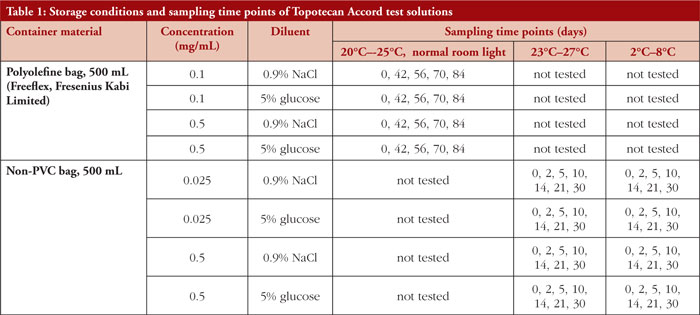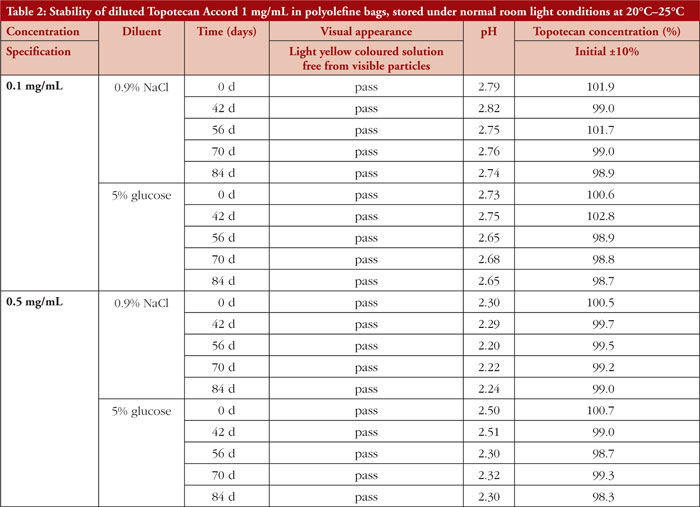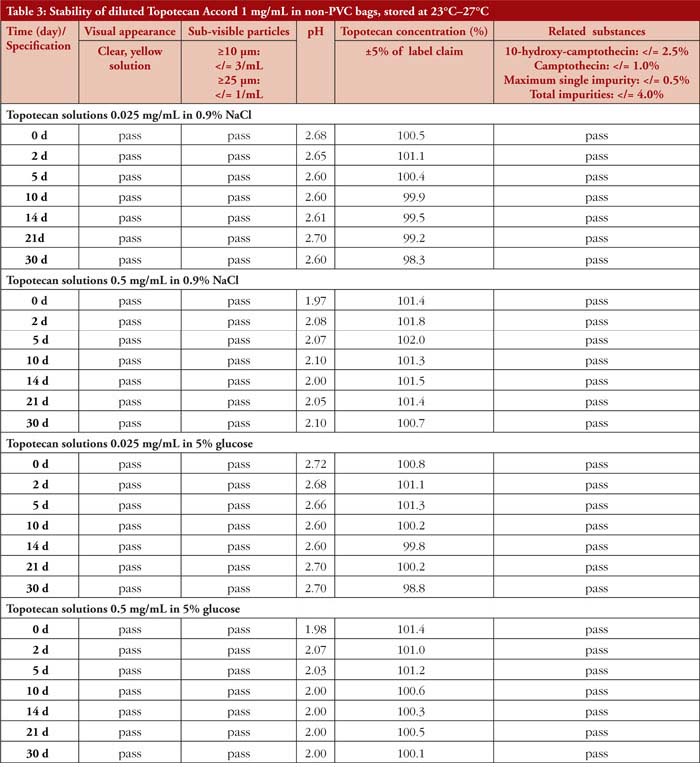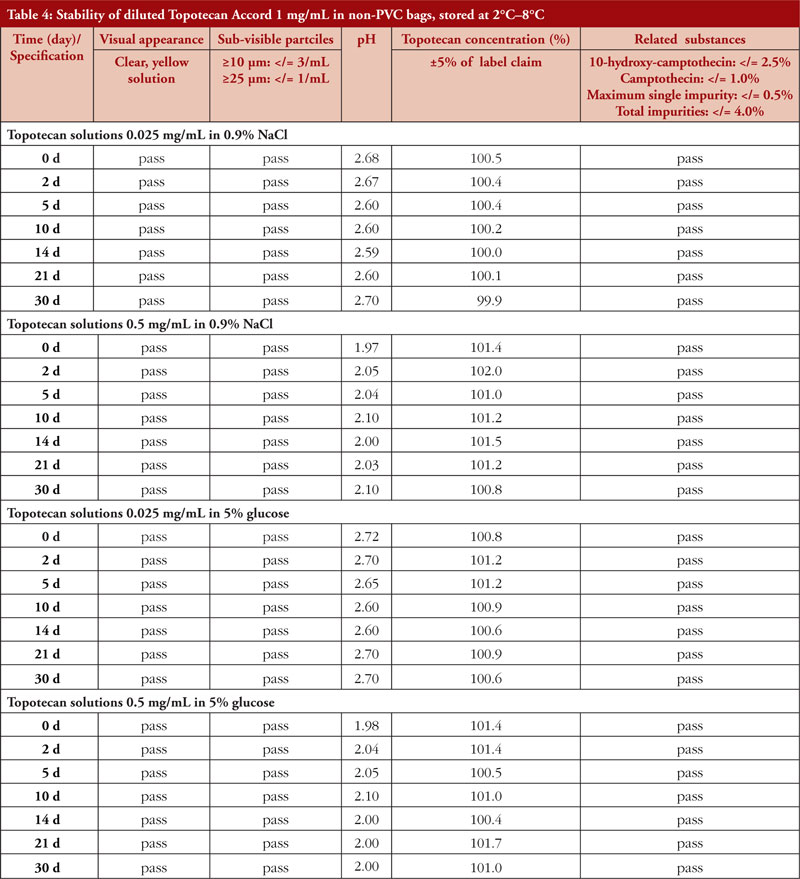Physicochemical stability of Topotecan Accord after dilution with 0.9% sodium chloride or 5% glucose solution in polyolefine and non-PVC bags
Published on 2024/09/11
Generics and Biosimilars Initiative Journal (GaBI Journal). 2024;13(2):79-83.
Author byline as per print journal: Irene Krämer, PhD; Frank Erdnuess, PhD; Judith Thiesen, PhD
|
Study objectives: To determine the physicochemical stability of Topotecan Accord 1 mg/mL concentrate diluted with 0.9% sodium chloride solution or 5% glucose solution in non-PVC and polyolefine (PO) bags to three different concentrations (0.025 mg/mL, 0.1 mg/mL, 0.5 mg/mL) and storage for up to 30 days and 84 days, respectively. |
Submitted: 29 February 2024; Revised: 15 April 2024; Accepted: 26 April 2024; Published online first: 6 May 2024
Introduction
Topotecan belongs to the group of antineoplastic camptothecin derivatives, which act as DNA topoisomerase I inhibitors, inducing single-strand breaks, replication arrest, and lethal DNA damage. Topotecan Accord is indicated for the second-line treatment of metastatic ovarian carcinoma and, in combination with cisplatin, for the treatment of relapsed small cell lung cancer [1].
In aqueous solutions, topotecan undergoes a pH-dependent reversible cleavage of the active ring-closed form to the inactive ring-open carboxylate form. Acidic pH values below pH 4.0 favour the presence of the active ring-closed form [2]. Thus, licensed topotecan medicinal products contain tartaric acid to ensure a stability-promoting acidic pH value after dilution [1].
The physicochemical stability of the undiluted topotecan concentrate in punctured original vials is established over a period of 28 days [3, 4]. Diluted topotecan infusion solutions (in pre-filled 0.9% sodium chloride or 5% glucose infusion bags) are known to be physicochemically stable for up to 30 days when stored light protected at 2°C–8°C or under normal light conditions at 25°C [1, 3].
Study objectives
The aim of this study was to determine the physicochemical stability of Topotecan Accord 1 mg/mL after dilution with 0.9% sodium chloride or 5% glucose solution in 500 mL non-PVC and polyolefine (PO) bags at concentrations of 0.025 mg/mL, 0.1 mg/mL, and 0.5 mg/mL under different storage conditions for a maximum period of 84 days.
Methods
Topotecan test solutions were prepared under EU Class A conditions and in accordance with the principles of Good Manufacturing Practice. A total of eight different test solutions were prepared using the European Medicines Agency (EMA) licensed Topotecan Accord 1 mg/mL (batch numbers L04704 and ASTPTP2013). Samples were taken and analysed initially (Day 0) and at predetermined time points. For detailed information, see Table 1.
The physical stability of test solutions was assessed by pH measurements (glass electrode) and visual inspections under standard laboratory light for any changes in colour, clarity, or the presence of particulate matter (for solutions in non-PVC bags in clean test tubes). In diluted topotecan test solutions prepared in non-PVC bags, osmolality and sub-visible particle numbers were measured on Day 30 of storage (end of the storage period). Particles were counted by light obscuration. The acceptance criteria for particulate matter ≥10 μm and ≥25 μm were maximum 25/mL and 3/mL, respectively.
Chemical stability was assessed via high-performance liquid chromatography (HPLC) assay, which has been validated for linearity of analytical response and acceptable precision. The assay was proven to be stability-indicating for non-specific degradation of the parent drug [5].
Acceptance criteria were set to a concentration of ±5% of the label claim for diluted test solutions in non-PVC bags and ±10% of the label claim for diluted test solutions in PO bags [5]. In diluted Topotecan Accord test solutions prepared in non-PVC bags, the type and quantity of related substances were analysed. Peaks in the HPLC chromatograms were identified by their relative retention times, and the percentage rates were calculated in relation to the main peak area. Acceptance criteria for the peaks were set as follows [5]:
- 10-hydroxy-camptothecin: </= 2.5%
- Camptothecin: </= 1.0%
- Maximum single impurity: </= 0.5%
- Total impurities: </= 4.0%
Results
The diluted Topotecan Accord 1 mg/mL test solutions stored in PO-bags and non-PVC bags remained physicochemically stable regardless of the topotecan concentration (0.025 mg/mL, 0.1 mg/mL, 0.5 mg/mL), the type of vehicle solution (0.9% sodium chloride, 5% glucose solution), and storage temperature. Neither colour changes, nor turbidity or visible particles were noticed during visual inspection. Results of pH measurements showed only slight variations (less than 0.7 units) during the observation period. The HPLC assays revealed only slight variations of topotecan concentrations at different time points, which are considered to be related to the assay variability, see Table 2.
In the corresponding HPLC chromatograms of diluted Topotecan Accord solutions in non-PVC bags, several peaks of related substances were detected. The peak related to 10-hydroxycampothecin was identified by its relative retention rate. Peaks of unknown impurities amounted to a maximum of 0.3%, and total impurities amounted to a maximum of 0.63% of the main peak, thereby fulfilling the acceptance criteria. Results of osmolality measurements showed only slight variations (less than 10 units) during the observation period. Results of sub-visible particle measurement also fulfilled the acceptance criteria. For detailed results, see Tables 3 and 4.
These results are in accordance with the results of previous investigations of various topotecan brand products, which demonstrated a physicochemical stability of at least 28 days for both diluted and undiluted topotecan solutions, regardless of storage temperature [1, 3].
Conclusion
After dilution with 0.9% sodium chloride or 5% glucose infusion solution to concentrations of 0.025 mg/mL, 0.1 mg/mL, and 0.5 mg/mL topotecan, test solutions of Topotecan Accord in non-PVC bags and PO bags revealed to be physicochemically stable over the test period of 30 days and 84 days, respectively, regardless of the storage conditions. Thus, diluted infusion solutions of Topotecan Accord, with topotecan concentrations between 0.025 mg/mL and 0.5 mg/mL, may be prepared in advance by pharmacy-based cytotoxic preparation units and used over a period of up to 84 days.
Analysis was performed and documented by an accredited external laboratory. Results were carefully checked for plausibility and cautiously interpreted.
Funding sources
This study was funded by Accord Healthcare.
Competing interests: The authors Irene Krämer, Frank Erdnuess, and Judith Thiesen have no competing interests to declare.
Provenance and peer review: Not commissioned; externally peer reviewed.
Authors
Professor Irene Krämer, PhD
Frank Erdnuess, PhD
Judith Thiesen, PhD
Department of Pharmacy, University Medical Center of the Johannes Gutenberg University Mainz, 1 Langenbeckstraße, DE-55131 Mainz, Germany
References
1. Accord Healthcare Limited. Summary of product characteristics for Topotecan Accord 1 mg/mL concentrate for solution for infusion. Available from: https://www.hpra.ie/img/uploaded/swedocuments/Licence_PA2315-121-001_28062023143046.pdf
2. Underberg WJ, Goossen RM, Smith BR, Beijnen JH. Equilibrium kinetics of the new experimental antitumour compound SK&F 104864-A in aqueous solution. J Pharm Biomed Anal. 1990;8(8-12):681-3
3. Thiesen J, Krämer I. Stability of topotecan infusion solutions in PVC bags and elastomeric portable infusion devices. J Oncol Pharm Pract. 1999;5(2):75-82.
4. Patel K, Craig SB, McBride MG, Palepu NR. Microbial inhibitory properties and stability of topotecan hydrochloride injection. Am J Health Syst Pharm. 1998;55(15):1584-7.
5. Accord Healthcare Limited. Data for HPLC assay and acceptance criteria on file; 10-07-12 and 30-05-14.
|
Author for correspondence: Judith Thiesen, PhD, Department of Pharmacy, University Medical Center of the Johannes Gutenberg University Mainz, 1 Langenbeckstraße, DE-55131 Mainz, Germany |
Disclosure of Conflict of Interest Statement is available upon request.
Copyright © 2024 Pro Pharma Communications International
Permission granted to reproduce for personal and non-commercial use only. All other reproduction, copy or reprinting of all or part of any ‘Content’ found on this website is strictly prohibited without the prior consent of the publisher. Contact the publisher to obtain permission before redistributing.






